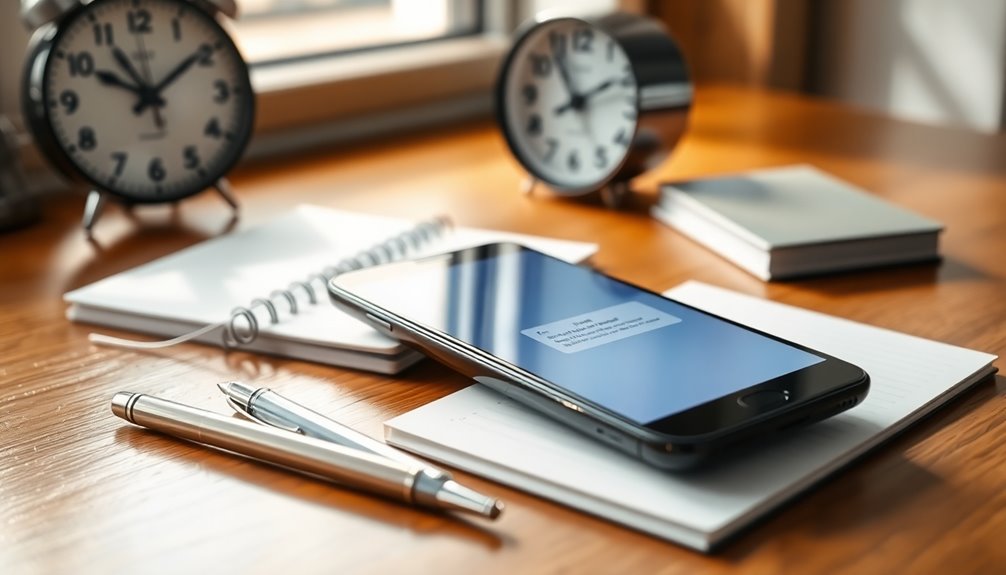To hear back after your interview in days, not weeks, you should act quickly. Send a thank-you email within 24-48 hours to express gratitude and reiterate your interest. Mention specific moments from the interview to make it personal. If there's no response after 5-10 business days, a polite follow-up can keep you on their radar. Utilize different channels like LinkedIn or a phone call for follow-ups, and maintain a professional tone throughout. Consistent communication balances staying engaged without overwhelming the hiring manager. There's a lot more to effective follow-ups—discover additional tips to enhance your strategy!
Key Takeaways
- Send a thank-you email within 24-48 hours of the interview to express gratitude and reinforce your interest.
- Highlight memorable moments from the interview to personalize your follow-up message.
- Inquire about the hiring process status and next steps in your follow-up communication.
- Use multiple channels, like LinkedIn and phone calls, to maintain engagement without being intrusive.
- Follow up consistently, with additional check-ins if you haven't heard back within a week.
Timing Your Follow-Up

Timing your follow-up after an interview can considerably impact your chances of making a positive impression. You want to strike the right balance between demonstrating enthusiasm and allowing the interviewer to process the meeting. Ideally, send your initial follow-up email within 24-48 hours after the interview. This timeframe gives you a chance to reflect on the conversation and craft a thoughtful message.
If you're keen to show your interest, consider sending a brief note on the same day, but wait a few hours to avoid appearing overly eager. If the interviewer mentioned a specific timeline for decision-making, respect that and wait until it's passed before reaching out.
In the absence of a timeline, allow five to ten business days before sending a gentle reminder. Always remember to take into account business days rather than calendar days. If you haven't received a response after a week, it's acceptable to send a second follow-up, ensuring you maintain a polite and professional tone. Follow-up timing is essential for demonstrating your continued interest, so be mindful of the appropriate intervals. Patience is key, as hiring processes can be slow, and you should continue your job search in the meantime.
Effective Follow-Up Methods

After an interview, choosing the right method for your follow-up can greatly enhance your chances of making a lasting impression. Email is the most common and efficient medium for this purpose, allowing you to send your message immediately. However, consider sending a handwritten thank-you note if you want to stand out and leave a more meaningful impact. Think about the company culture and the interviewer's preferences when deciding which medium to use.
Personalize your follow-up by referencing specific points from your conversation. Highlight aspects of the job or company culture that resonate with your goals, showing genuine interest. Mention memorable interactions or discussions to reinforce why you're a strong fit. Expressing gratitude at the beginning of your follow-up can help set a positive tone and demonstrate your professionalism.
If any concerns were raised during the interview, use this opportunity to address them. Provide additional information or context to alleviate any doubts the interviewer may have. Confirm that everything you include is relevant and supports your candidacy.
Finally, remember to respect the hiring process timelines. Avoid being overly persistent; wait the recommended time before sending a follow-up reminder. Keep your messages positive and enthusiastic, and proofread carefully to maintain professionalism.
Crafting Your Follow-Up Message

Finally, include relevant details by recapping memorable moments or topics from your conversation. Highlight how your skills align with the job requirements and mention any new information you've learned since the interview that reinforces your fit for the role. This approach guarantees you leave a lasting, positive impression. Additionally, remember that a well-crafted follow-up email can significantly enhance the candidate's perception of the organization.
Personalizing Your Communication

Personalizing your follow-up communication is essential for making a memorable impact after your interview. Start by addressing your email directly to the interviewer(s) by name. This simple gesture shows you value their time and input. Next, mention specific topics or challenges discussed during your interview. This illustrates your engagement and genuine interest in the role.
Incorporate details about the company's culture or mission that you discussed. Referencing these elements indicates you're not just interested in any job, but specifically in this opportunity. Highlight your relevant skills and experience by tailoring the email to align with the job requirements and the conversation you had. Additionally, using interview follow-up templates can streamline your communication and help you stay organized in your job search.
Don't forget to include personal touches, like anecdotes or insights that surfaced during your chat. These can make your email more memorable. Reference key moments or achievements discussed to reinforce your qualifications. Express your enthusiasm for the role and how it aligns with your career aspirations.
Lastly, maintain professionalism by proofreading your email to confirm it's polished and concise. Include your contact information, and send the follow-up within 24 hours to keep the momentum going.
Demonstrating Continued Interest

Following up with personalized communication sets the stage for demonstrating your continued interest in the role. It's essential to convey your enthusiasm and appreciation effectively. Here's how you can do this:
- Show Appreciation: Send a thank-you email within 24-48 hours. Express gratitude for the interviewer's time and mention specific aspects you enjoyed or found insightful.
- Reiterate Interest in the Role: Clearly state your continued interest in the position. Highlight how the interview strengthened your enthusiasm and why the company's culture aligns with your personal goals. This reinforces the importance of follow-up emails in maintaining engagement with potential employers.
- Ask About Next Steps: Inquire about the status of the hiring process and ask if the position has been filled. Showing initiative here demonstrates your willingness to stay involved.
- Maintain Professionalism: Keep your follow-up concise and structured. Use a professional tone, include your contact information, and end with a polite closing.
Building Value in Your Follow-Up

Building value in your follow-up can greatly impact the hiring manager's perception of you. Start by adding relevant information, like a link to an article or industry news that came up during your interview. Reference specific topics discussed to jog the interviewer's memory and show you were engaged in the conversation. If you've learned something new since your last chat, share it—this demonstrates your initiative. Remember, effective communication is vital in relationship dynamics, particularly in professional settings.
Personalize your message by tailoring each follow-up to the specific interviewer. Mention shared interests or personal connections, and highlight aspects of the company or role that thrilled you. Use concrete details from your conversation to reinforce your enthusiasm.
Show your engagement by sending additional insights or corrections if necessary. Illustrate how your skills align with the job requirements, and offer to answer any further questions. This showcases your willingness to contribute. Sending a follow-up email within 24 hours can also reinforce your interest in the position and keep communication open with hiring managers.
Finally, enhance your professional image by maintaining a polished tone. Keep your email concise, with a clear subject line, and proofread it for errors. By doing this, you'll leave a lasting impression that may just land you the job you desire.
Long-Term Follow-Up Strategy

A solid long-term follow-up strategy can keep you on the radar of hiring managers even after the initial interview. Here's how to maintain that connection effectively:
- Wait to Follow Up: After your interview, give it at least five business days before sending a follow-up email. Respect any timeline the manager provided, and if none was given, wait at least a week.
- Craft Thoughtful Messages: Start your follow-up with a thank-you note, mentioning the position you interviewed for. Keep it short and express why you're a strong candidate. Additionally, make sure to send a thank-you email within a few hours to reinforce your interest.
- Periodic Check-Ins: If the process seems to drag, send check-in messages about once a month. Offer value by sharing relevant articles or congratulating them on new developments without expecting an immediate response.
- Utilize Multiple Channels: Send a thank-you note within 24 hours of the interview. Use email for follow-ups, and consider connecting on LinkedIn for professional rapport. If appropriate, make a follow-up call after a week or two, using a prepared script for clarity.
Implementing these strategies can help you stay top-of-mind for hiring managers in the long run.
Maintaining Professional Relationships

Maintaining professional relationships is essential for long-term career success, especially in today's competitive job market. Building trust starts with proactive communication. Regularly check in with your network, offering constructive feedback and acknowledging their strengths. This openness fosters a supportive atmosphere, regardless of immediate job opportunities.
Keep communication alive by sending follow-up emails or messages that provide updates. Mention current industry events to show you're engaged and interested. Connecting on social media platforms can also expand your professional network, allowing for continued interaction. Share valuable resources or articles that might benefit your contacts, but be mindful of the frequency to avoid being intrusive. Additionally, retaining connections with candidates can foster a talent pool for future openings and enhance the overall candidate experience.
To add value, offer guidance without expecting anything in return. Clearly communicate the benefits of your requests and provide insights into market trends. Help candidates stand out by offering assistance with resume optimization and interview tips.
Ultimately, develop a partnership based on mutual dedication to career objectives. Foster loyalty by showing ongoing support and encouraging continuous learning. By maintaining these relationships, you not only enhance your network but also position yourself for future opportunities and growth.
Frequently Asked Questions
What Should I Do if I Don't Hear Back After Following Up?
If you don't hear back after following up, it's best to stay patient and professional. Consider sending a brief second follow-up email to confirm receipt of your initial message. Wait about a week before reaching out again, and keep your tone positive. If email isn't working, try a phone call. Meanwhile, keep applying elsewhere and networking, so you stay proactive in your job search. Don't lose hope; the right opportunity is out there!
How Many Times Should I Follow up With an Employer?
So, you think following up is like sending a carrier pigeon, huh? Well, you can follow up twice, but don't overdo it! Aim for a thank-you email within 24 hours, then wait five business days for your first follow-up. If you still don't hear back, give it another week before trying again. Patience is key—remember, they're not ignoring you; they're just busy with their own drama! Keep it professional and respectful.
Is It Appropriate to Follow up on Weekends?
It's generally not appropriate to follow up on weekends. Hiring managers are often occupied with personal matters during this time, and your message might get overlooked. Instead, wait until business days to reach out; this shows respect for their time and increases the chances of a prompt response. You can always send a thank-you note right after the interview, but save detailed follow-ups for when they're likely to be available.
Can I Follow up if I Interviewed With Multiple People?
Yes, you can absolutely follow up if you interviewed with multiple people. It's best to send individual thank-you notes to each interviewer within 24 hours, referencing specific points from your conversations. After that, wait at least five business days before reaching out again. Personalize your follow-up emails, expressing gratitude and asking about the hiring timeline. This shows your genuine interest and keeps you on their radar without coming off as pushy.
Should I Follow up Differently for Remote vs. In-Person Interviews?
You don't need to follow up differently based on whether your interview was remote or in-person. The key is to express gratitude, reiterate your interest, and reference specific points from your conversation, regardless of the format. Just keep your follow-up concise and professional. Use the same medium you communicated through initially, and always personalize your message to stand out. Consistency is what's important, not the method of the interview.
Conclusion
Following up after your interview is like planting seeds in a garden—you nurture your chances of blooming into a job offer. By timing your follow-up right and crafting personalized messages, you show you're not just another candidate lost in the shuffle. Keep the lines of communication open, and showcase your enthusiasm and value. Remember, every interaction builds the foundation for a lasting professional relationship. Your next opportunity might just be a follow-up away!
Emmeline is the backbone of our content creation team, bringing complex psychological concepts to life with clarity and empathy. As our Expert Writer, she crafts engaging, insightful articles that guide readers through the intricacies of personality assessments and what they reveal about the human condition. Her passion for psychology and personal development shines through in every piece she writes.










